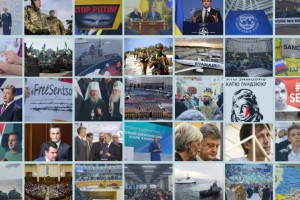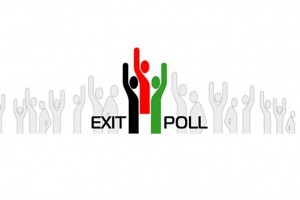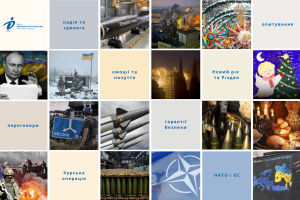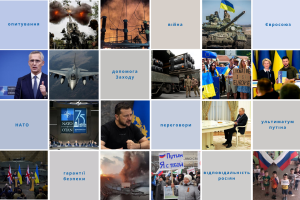The results of the sociological survey conducted by the Ilko Kucheriv Democratic Initiatives Foundation together with the sociological service of the Razumkov Center from August 5 to 12, 2022, with the grant support of the University of Bremen and the International Renaissance Foundation. Some questions were financed by the program Documenting Ukraine, conducted by the Institute for Human Sciences, Vienna (IWM)
The face-to-face survey was conducted in Vinnytsia, Volyn, Dnipropetrovsk, Zhytomyr, Zakarpattia, Zaporizhzhia, Ivano-Frankivsk, Kyiv, Kirovohrad, Lviv, Mykolaiv, Odesa, Poltava, Rivne, Sumy, Ternopil, Kharkiv, Khmelnytskyi, Cherkasy, Chernihiv, Chernivtsi oblasts and the city of Kyiv (in Zaporizhzhia, Mykolaiv and Kharkiv oblasts – only in territories controlled by the Ukrainian government and where no hostilities are taking place).
The survey was conducted in 112 settlements (57 urban and 55 rural) by stratified multistage sampling using random sampling at the first stages of sampling and quota sampling at the final stage (when respondents were selected by gender and age quotas). The sampling structure represents the demographic structure of the adult population in the territories where the survey was conducted at the beginning of 2022 (by age, gender, and type of settlement).
2.024 respondents aged 18 years and older were surveyed. The theoretical error in sampling does not exceed 2.3%. At the same time, additional systematic deviations in sampling may be due to the consequences of Russian aggression, in particular the forced evacuation of millions of citizens.
Composition of macroregions:
- The West – Volyn, Zakarpattia, Ivano-Frankivsk, Lviv, Rivne, Ternopil, Chernivtsi oblasts;
- The Center – Vinnytsia, Zhytomyr, Kyiv, Kirovohrad, Poltava, Sumy, Khmelnytsky, Cherkasy, Chernihiv oblasts and the city of Kyiv;
- The South – Mykolaiv and Odesa oblasts;
- The East – Dnipropetrovsk, Zaporizhzhya, Kharkiv oblasts.
Trust in government agencies and social institutions
- Despite the challenges of war and the pressure of Russian propaganda, Ukrainians' trust in state and social institutions is only growing.
- Compared with the results of the August 2021 survey of the Democratic Initiatives Foundation, as of August 2022 the balance of trust in all state[1] agencies and social institutions included in the survey has increased among Ukrainians. The exception is low trust in political parties. The growth of public trust indicates a high level of social cohesion among citizens.
- In a year, the balance of trust in the President of Ukraine grew the most (+92%). The balance of trust in the key state agencies that are now engaged in the protection of the state has increased by more than 50%: MIA (+65%), the National Guard (+64%), National Security and Defence Council (+56%), National Police (+54%), State Bureau of Investigation (+53%), State Border Guard Service (+53%), volunteer detachments (+52%) and the State Emergency Service (+50%).
- As of August 2022, the largest positive trust balance have: AFU (91%), State Emergency Service (82%), the National Guard (81%), volunteer organizations (77%), State Border Guard Service (74%), volunteer detachments (73%) and the President of Ukraine (71%). Ukrainians least trust political parties (-55%), the judicial system (-46%), officials (-46%), commercial banks (-37%) and the Verkhovna Rada (-19%).
- Thus, over the year (from August 2021 to August 2022) the top three government agencies and social institutions by balance of trust have changed as follows: The Armed Forces of Ukraine retained their positions; the State Emergency Service and the National Guard ousted the volunteer organizations and the church; the top three outsiders remained unchanged.
- Among the respondents who trust the President of Ukraine, more than 90% are convinced that Ukraine will win the war. Those who do not trust the President are less likely to believe that Ukraine will win. However, the majority of these respondents (64%) also believe that Ukraine will win the war.
Are Ukrainians prone to paternalism?
- The vast majority of Ukrainians continue to stand on the side of minimal government interference in people's lives. Thus, 53% of respondents agreed with the statement that the state should only provide people with equal "game rules," and then everyone is responsible for how these chances will be used.
- The opposite opinion is shared by 40% of Ukrainians, who are more open to the concept of the welfare state. They believe that the state should be fully responsible for providing everyone with everything they need. Compared to 2021, the proportion of respondents who chose each option changed within the statistical error.
- The argument that the state should provide everyone with everything they need is more often supported by those categories of the population who are generally more dependent on social support programs of the state. 51 percent of respondents over 60 support the idea of a welfare state, while among those surveyed in the 18-29 age group only 30 percent expect the state to provide them with everything they need. Similarly, 58 percent of respondents under the poverty line believe that the state should provide them with everything they need, with only 42 percent of financially well-off respondents agreeing.
- Despite the fact that the majority of Ukrainians support the idea that the state should limit itself to guaranteeing a more equal game rules, 73% believe that the majority of the population, nevertheless, will not be able to live without constant care from the state.
- It seems that the destabilization caused by the full-scale war has only reinforced this view. Over the year, the proportion of respondents who believed that people would not be able to live without the care of the state increased by 8%.
- The greatest difference in opinion of the need for state care was among respondents of different ages and with different property statuses. Among the youngest age group (18-29 years old), 63% believe that the state needs to provide care. In the oldest age group (≥60 years) this thesis is supported by 81%. 65% of the financially well-off believe that most people would not be able to survive without government support; 81% of extremely poor respondents agree.
Emotions and feelings of Ukrainians during the war
- During a full-scale war, the vast majority look toward their future and the future of Ukraine with hope. It is hope as well as optimism and anxiety that are the three key emotions of Ukrainians today, both at the personal level and at the level of the state.
- When thinking about their own future, Ukrainians are slightly more likely to feel confused (19%) than when thinking about the future of Ukraine (9%). Conversely, when thinking about the future of the state, Ukrainians feel a little more confident (24%) than when thinking about their own future (17%).
- When thinking about their future, women more often than men reported such emotions and feelings as confusion (+7%), hope (+7%), anxiety (+10%), and fear (+7%), but less often than men felt optimistic (-7%) and confident (-6%).
- Ukrainians living below the poverty line are more pessimistic about their future than wealthy Ukrainians. They are 12% more likely to be frustrated, 11% more likely to be confused, 22% more likely to be anxious, 9% more likely to be afraid, and 26% less likely to be optimistic. Nevertheless, the sense of hope is almost equally strong among poor and rich.
- Differences in feelings and emotions among respondents with different property statuses also maintain in the question of the vision of the future of Ukraine. The poorest segments of the population are 5% more likely to be confused, 9% more likely to be anxious, and 8% more likely to fear the future of the state. However, among Ukrainians living below the poverty line, a sense of hope in the context of Ukraine's future is 10% more common than among the wealthy segment of society. Financially well-off respondents were more likely to report feelings of optimism (+22%) and confidence (+14%).
- Young people (18-29 years old) are more optimistic and confident about the future of Ukraine than people over 60 years old. However, their sense of hope for the future of the state is equally strong.
- Compared with the year 2021 Ukrainians have significantly more often felt optimism (+12%), confidence (+16%) and hope (+23%) when thinking about the future of Ukraine. The feeling of anxiety and fear remained almost[2] at last year's level.
- Over the time that the Democratic Initiatives Foundation has conducted surveys on respondents' emotions and feelings, the highest proportion of respondents who experienced anxiety and fear was in 2015: 39% and 15%, respectively. Compared with the results in 2015, Ukrainians today are 8% less likely to feel anxiety, thinking about the future of the state, and just as often as in 2015, fear.
1 Calculated as the difference between the share of those who trust and those who do not.
2 Difference within statistical error








